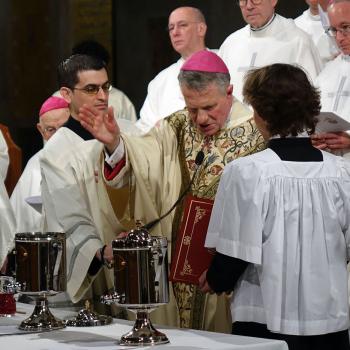The Catholic Church encourages all the faithful who are able, to read scripture, meditate on it and use it in prayer. Yet, the task of choosing a Bible can be overwhelming. The modern book store is filled with dozens of various translations, editions, and formats. Making the wrong choice is easy. Many editions have removed books and sections of the Old Testament. Some translators have made changes to fit their own theology and preferences that obscure the original meaning of the text. Other editions might include footnotes that include poor interpretations of the text, or heresies.
Which Translation?
The responsibility of commissioning and approving translations of the Bible for Catholics falls to conferences of Catholic Bishops. In the United States, the USCCB (United States Conference of Catholic Bishops) is at the center of most of the decisions surrounding what scriptures to use. In the USA the USCCB has approved the use of the New American Bible (NAB) for use in the liturgy. Reading you hear in Mass in the United States will be taken from this translation. Other counties use other translations in the celebration of the Mass, and beyond the NAB there are many translations of scripture that have been approved for use by the Catholic faithful.
There are lots of other translations that have been approved by Catholic Bishops for Catholic study and devotional use as well. Some of the more common additional translations are:
-
Douay–Rheims Bible – Based on the Latin Text, this is an older translation but is still used by a significant number of people.
-
Jerusalem Bible – Based on a 1956 French translation called Bible de Jérusalem, with some reference to the ancient sources this is a translation with a very dynamic approach to the scriptures. It represents the thoughts of ancient manuscripts more than strict adherence to the words.
-
New Jerusalem Bible – This is a newer translation that is drawn from the ancient sources of scripture, and only turns to the Bible de Jérusalemin informing some of the stylistic choices.
-
Revised New Jerusalem Bible – A further revision of the Bible de Jérusalemtradition in English. This version moves toward a more formal “word-for-word” translation and grounds its translation of the book of Psalms on the Revised Grail Psalter (which is the Psalm Translation tradition that informs the Liturgy of the Hours in many regions).
-
New Revised Standard Version Catholic Edition – This is a Catholic version of the Updated Revised Standard Version (RSV). This edition uses more gender-inclusive language and eliminates some of the archaic English pronouns (i.e. thee, and thou) in the Psalms, along with minor updates to the source material based on contemporary scholarship.
-
English Standard Version Catholic Edition – This is a Catholic version of another update to the Revised Standard Version. This translation updates some of the language and scholarship but does not utilize as much gender-inclusive language as the NRSV. It also intended to address some of the criticism of the earlier RSV for having “liberal influence.” The ESV, RSV, and NRSV all employ a “word-for-word” approach to translating the text, and so are fairly close in their translations to the texts of the original manuscripts.
-
Good News Translation Catholic Edition– A Dynamic equivalence translation, this translation has been popular for many years because it is considered very easy to read. However, it is a less literal translation than most on this list.
-
New Living Translation Catholic Edition – Similar to the Good News Translation, the New Living Bible is easy to read because of its use of a “dynamic equivalence” approach to the text. It is informed in part by the language used in The Living Bible, published in 1971, which is a paraphrase of the 1901 “American Standard Bible.” The American Standard Bible was a revision of the King James Version and served as the basis of the Revised Standard Version. The New Living Translation returned to the original manuscripts as the basis of its translation, which differentiates it from the Living Bible which did not.
-
New American Bible: Revised Edition – This is an updated version of the NAB, the translation used for readings in Mass in the United States. It employs more of a formal equivalence in its translation, presenting more of a “word-for-word” translation rather than a thought for thought translation. Special attention was paid in the revisions of the Psalms in order to present an accurate literal translation of words and images and to present the English with attention to presenting rhythum. It also focuses on ease in recitation and singing.
The Catholic Church doesn’t have one translation of the Bible that they use. But many. Choosing which translation and edition of the scriptures to use will vary with your needs. If you are looking for something that is easy to comprehend a “thought-for though” dynamic equivalence may be a good choice. However, if you are looking for a translation that connects you more closely to the words of the original manuscripts a “word-for-word” translation is probably preferable. For those who want a text that matches what they hear at Mass outside of the United States, they should consult their diocese to learn which translation is employed in their region.

















